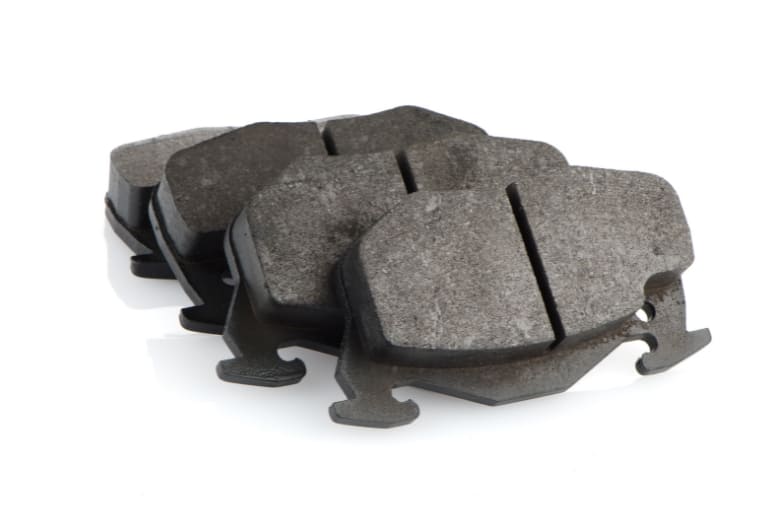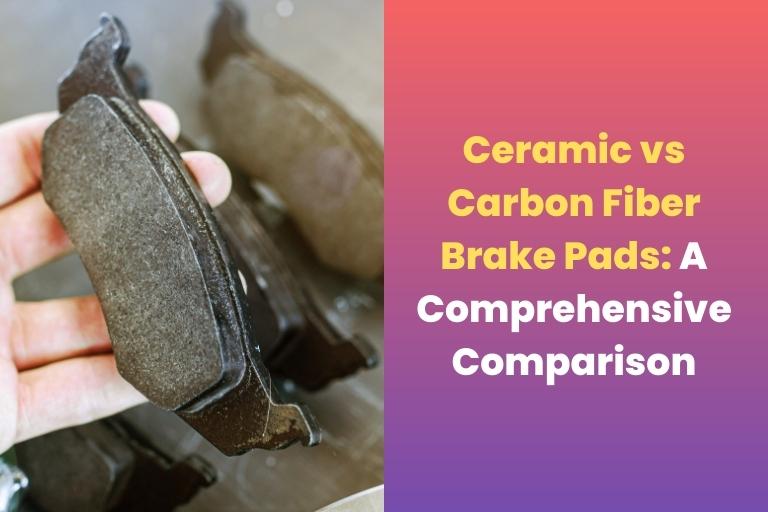Brake pads are such a little word to write, and they may appear to be a minor component of your vehicle. However, they perform the most essential function in keeping you safe on the road. Imagine driving your car at full throttle and suddenly realizing your brake pads aren’t working. Isn’t it terrible?
To avoid such situations, it is better to invest a little more money in decent brake pads. When it comes to selecting good brake pads, two prominent choices stand out:
- Ceramic brake pads
- Carbon fiber brake pads
In this article, we’ll look at the comparison between ceramic and carbon fiber brake pads. Both brake pads are good. However, they have various advantages and disadvantages. Let us go into this and examine the distinction in depth.
Contents
Ceramic vs. carbon fiber brakes: In-depth Comparison

Both ceramic brake pads and carbon fiber brake pads are suitable for different circumstances and have distinct specializations and functionality. Let us go through them all one by one.
Construction
Ceramic brake pads are primarily made of ceramic fibers that are strengthened with metal and a bonding agent for structural stability. Small copper fibers are also included in the ceramic mixture to improve heat conductivity and friction.
Carbon fiber brake pads, in contrast, are created by mixing carbon fiber with silicone resin. This mixture is then compacted at a pressure of 20,000kg before being baked at 200°C and rapidly cooled. These stages result in the basic structure of carbon ceramic brakes. The braking system incorporates a meticulously processed disc or rotor comprised of carbon fiber, silicon carbide, and epoxy resin. Carbon fiber and ceramic materials work together to create a high-performance option for your vehicle.
Function
Ceramic brake pads reduce brake wear using ceramic composite materials and novel roller designs. They offer a far longer lifespan than standard brake pads, with a possibly more than three years warranty when used correctly. These pads shorten the braking distance and save 75% of the effort required. Ceramic brake pads provide exceptional heat resistance and reduce heat fade, allowing faster recovery after stopping at a sign or signal.
Carbon fiber brake pads perform similarly to traditional pads. They were initially designed for big airplanes and use carbon fiber brake rotors and carbon brake pads to provide excellent stopping force while maintaining outstanding heat stability and thermal conductivity.
Cost
Ceramic brake pads are more costly because of their superior manufacturing and heat-resistant qualities.
Carbon fiber brake pads are often less expensive than ceramic brake pads.
Weight
Ceramic brake pads are lighter than carbon fiber pads, which reduces unsprung weight and improves overall vehicle performance.
Carbon fiber pads are heavier than other choices but still lightweight.
Heat and wear resistance
Ceramic brake pads provide excellent heat resistance, minimizing brake fade even under heavy braking. They also have reduced wear rates, which leads to a longer lifespan.
Carbon Fiber Brake Pads are extremely heat resistant and can withstand high temperatures without compromising performance. They have excellent wear properties.
Noise
Ceramic brake pads are noted for their quiet functioning, producing less noise while braking and giving a smooth driving experience.
Carbon Fiber Brake Pads make less noise when braking, resulting in a quieter ride.
Dust
Ceramic Brake Pads create substantially less brake dust, keeping your wheels cleaner.
Carbon fiber pads produce comparatively more dust.
Braking Performance
Ceramic brake pads provide consistent and predictable braking performance, with a strong initial bite and shorter stopping distances.
Carbon fiber brake pads provide a powerful initial bite and consistent braking performance for improved control.
Longevity
Ceramic brake pads have a longer lifespan due to their more excellent wear resistance, lasting more kilometers before needing to be replaced.
Carbon fiber pads are incredibly durable and have a long service life.
Overall
Ceramic Brake Pads Although more expensive, ceramic pads are recommended for their heat resistance, reduced dust output, quiet operation, and extended lifespan.
Carbon fiber brake pads are well known for their heat resistance, lightweight design, dependable braking performance, and low cost.
Comparison Table ceramic brake pads vs. carbon fiber brake pads
| CERAMIC BRAKE PADS | CARBON FIBRE BRAKE PADS | |
| COST | Expensive. The cost range between $ 50 – $ 100 | Comparativley cheaper. The cost range is between $ 25 – $ 60. |
| NOISE LEVEL | Little to no noise. Silent operation. | Produces more noise. |
| WEAR AND TEAR | The pads wear slowly but cause more rotor wear. | The pads wear faster but produce less wear and tear to the rotor |
| PERFORMANCE | Ideal for general use. But does not perform well under extreme conditions | Performs exceptionally well under extreme conditions |
| DUST | Generate less dust | Generate more dust |
| HEAT MANAGEMENT | Excelet head resistance. It cools down very fast but draws less heat from the rotor. | They retain more heat but draw more heat from the rotor. |
| PRIMARY APPLICATION | Ideal for everyday driving | Ideal for racing, towing, everyday driving, trucks, etc. |
| WEIGHT | Light-weight | Light-weight |
Advantages and disadvantages of ceramic and Carbon fiber brake pads
Advantages and disadvantages of ceramic brake pads
| Advatages | Disadvantages |
| Quieter operation | Poor absorber of heat |
| Reduced brake dust | Highly expensive |
| Long lifespan | Do not function in extreme cold or other extreme conditions |
| Better stoping power | Do not work for towing, heavy duty truck etc. |
| Variety in particle sizes | Rotors may be damaged (in rare situations) |
| Increased recovery time following a complete stop | It absorbs less heat than other friction compounds, as it may result in higher braking system temperatures. |
Advantages and disadvantages of Carbon fiber brake pads
| Advantage | Disadvantage |
| Exceptional heat resistance, maintaining performance under extreme conditions | Higher cost compared to some other brake pad (still cheaper than ceramic brake pads) |
| Suitable for racing, towing, and heavy-duty applications | Can generate more noise during braking |
| Lightweight, reducing unsprung weight for improved handling | More dust production compared to certain brake pad materials |
| Less wear and tear on the rotor, extending rotor life | Retain more heat, potentially affecting the overall braking system |
| Reliable performance under extreme conditions | It may require additional rotor cooling methods in some applications |
Which is better Ceramic brake pads or carbon fiber brake pads?
Which brake pads are superior, ceramic or carbon fiber, is determined by various criteria and personal preferences. Ceramic brake pads are ideal in terms of heat resistance, dust generation, silent operation, and longevity. They are appropriate for daily driving and offer consistent braking performance.
Carbon fiber brake pads, on the other hand, perform in harsh situations like racing or towing due to their great heat resistance and lightweight nature. They also generate less rotor wear and tear. Carbon fiber pads are more costly, make more noise, and retain more heat. Individual demands, driving style, and unique application requirements all influence the final decision.
Also, Read:
- How Close Should Brake Pads Be To Rotors?
- Can You Spray Brake Cleaner On Brake Pads? Does It Help?
- Can You Put Brake Pads On Backward? Why Should You Avoid?
- Brake Shudder After New Rotors And Pads? Here Is The Fix
- Are Brake Pads Interchangeable? Let’s Find Out
- Does The Emergency Brake Lock All Wheels?
- How Long Can You Drive On Grinding Brakes?
- Do Ceramic Brake Pads Contain Asbestos?
- Can You Use Front Brake Pads On The Rear?
- Why Does My Car Shake After Changing the Brake Pads?
- Should You Replace All 4 Brake Pads At Once?
- How to Install Anti-Rattle Clips on Brake Pads: Beginner’s Guide
- How Long Do Brake Pads Last: Brake Pad Lifespan Explained
- Driving Without Brake Pads: How Long is Safe?
- Fixing New Ceramic Brake Pads Making a Grinding Noise
- Ceramic vs. Semi-Metallic Brake Pads: Which is Better?
- Why Are My Brakes Grinding After New Pads And Rotors
- Ceramic vs OEM brake pads: Which is Better?
- Ceramic vs Organic Brake Pads: In-depth Comparison
Conclusion
In conclusion, both ceramic and carbon fiber brake pads have advantages and downsides. Ceramic brake pads are a good choice for everyday driving because of their great heat resistance, reduced dust emission, and extended lifespan.
Carbon fiber brake pads, on the other hand, shine under harsh circumstances, with outstanding heat resistance and less weight for increased performance. Carbon fiber pads may be cheaper, make more noise, and retain more heat.
Individual preferences, driving style, and unique application need all play a role in determining which brake pads are best. It is critical to thoroughly analyze these elements before selecting the best decision for your requirements. It is recommended to check all the factors discussed above and identify the best brake pads for your needs.
Brake pads may sound simple and easy, but it has to potential to save or risk your life in one instant. So, it’s better to think and research before finalizing the ideal brakes.
